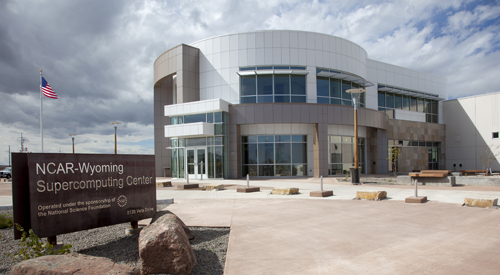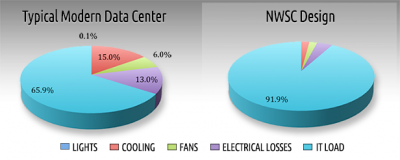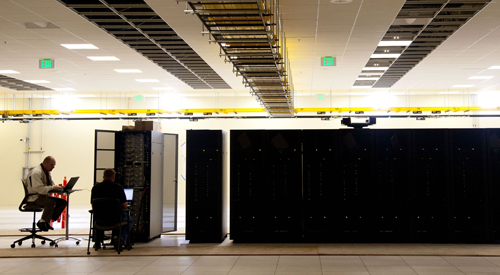Power meets efficiency
The NWSC brings four decades of big-data expertise to the next level
Oct 5, 2012 - by Staff
Oct 5, 2012 - by Staff
October 5, 2012 | Though it’s become a trendy concept, “big data” is a realm that NCAR scientists and their collaborators pioneered to help shape the nation’s infrastructure for weather prediction and related research. Largely because the atmosphere is so vast, and because tiny changes can have a major impact over time, atmospheric research involves enormous amounts of data. Over the last 40 years, hundreds of scientists at dozens of institutions have relied on NCAR’s computational muscle and massive data storage systems in order to make progress in forecasting weather, projecting future climate, and other key tasks. (See Key moments in NCAR supercomputing.)

Located on the western fringe of Cheyenne, Wyoming, the NCAR-Wyoming Supercomputing Center officially opens in October 2012. (©UCAR. Photo by Carlye Calvin. This image is freely available for media & nonprofit use.)
The latest chapter in the story of NCAR computing begins in the fall of 2012, as the NCAR-Wyoming Supercomputing Center opens for business. The center’s flagship hardware—an IBM system dubbed Yellowstone, in honor of Wyoming’s iconic national park—will rank among the speediest supercomputers in the world when it debuts. Yellowstone will feature 74,592 parallel processors, each carrying out calculations simultaneously when the supercomputer is running at its peak.
“We are delighted that Yellowstone is here,” says UCAR president Tom Bogdan. “This supercomputer and the NWSC as a whole will provide a long-sought and much-needed boost to the capabilities of researchers in the atmospheric and Earth sciences.”
 "We've tried to design a balanced system to support data-intensive supercomputing."
"We've tried to design a balanced system to support data-intensive supercomputing."—Anke Kamrath, director of operations and services for NCAR's Computational and Information Systems Laboratory
Years ago, it became clear that the computing center at NCAR’s Mesa Laboratory was reaching the limits of its ability to provide space, power, and cooling for ever-larger supercomputers. The center’s search for an alternative led to Cheyenne, where the NWSC now stands as the latest example of an expanding research corridor of tech-oriented development along the Front Range of the Rocky Mountains.
The NWSC will advance a broad range of geoscience research, with potential benefits to society in everything from storm prediction to air quality monitoring and the assessment of energy and water resources.
Yellowstone will provide almost 30 times the computing power of its NCAR predecessor, Bluefire. All else being equal, that might allow an experimental short-term weather forecast to be carried out in nine minutes versus three hours, or a climate projection to be produced in a week as opposed to half a year. The speed boost can also support more and better science in other ways, producing a greater number of simulations or increasing their complexity, depending on the goals of a given study.
The NWSC offers more than sheer power, though. Both the building and the supercomputing inside have been designed with maximum efficiency in mind. Cheyenne’s windy High Plains climate provides a great deal of natural cooling; the NWSC takes advantage of it through a louvered air lock system. With the help of this and other energy-saving features, more than 90% of the power entering the NWSC goes directly to its computational mission—a notable improvement on the rates of 70% or lower found at many data centers. And even before its doors opened, the NWSC garnered a LEED Gold rating for Leadership in Energy and Environmental Design from the U.S. Green Building Council.

More than 90% of the power entering the NWSC goes directly to its computational mission (IT LOAD), compared to about 66% for most data centers operating today. (Image courtesy NCAR/CISL.)
The Yellowstone supercomputer is highly efficient in its own right. Compared to Bluefire, the amount of power required by Yellowstone per unit of computing will be reduced by more than 85%, thanks to a variety of improvements in computing hardware. The machine promises to serve as a powerful proving ground for computational scientists—at NCAR and at research universities and labs around the country and the world—working to maximize the usefulness and nimbleness of weather and climate models.
While the NWSC’s grand opening is the climax to more than five years of planning and construction, it’s also just the beginning: the center is well equipped to serve scientists far into the future. Yellowstone occupies only part of the NWSC’s available computing spaces, or modules. Moreover, the facility is designed so that next-generation capacity can be added without disrupting current operations.

Housed in a set of 100 interconnected cabinets, the Yellowstone system includes more than 70,000 processors, as well as high-performance bandwidth, memory, and visualization functions to transmit, store, and view the results. (©UCAR. Photos by Carlye Calvin.)
Expanded scientific horizons will be part of the picture from the outset. The roster of initial projects encompasses a wide range of our environment’s fluid behavior, from the effects of sea spray on hurricanes to the motion of tectonic plates that leads to earthquakes. The NWSC is setting the stage for major progress in such critical areas as geophysical turbulence, which not only rattles aircraft but influences the behavior of countless processes all around us.
With an ever-broadening range of disciplines represented, and new scientific partnerships already taking shape, the NWSC could go a long way toward helping us steward our planet’s resources, preserve its health, and avoid the natural hazards that so profoundly affect people and the economy.
“The vision for Yellowstone parallels the principles that have guided the design of the NWSC,” says NCAR director Roger Wakimoto. “In both instances, we have taken an approach that maximizes the science we can do and the benefit of that science to society.”

The NCAR-Wyoming Supercomputing Center in Cheyenne, Wyoming, takes advantage of naturally cool air and many other energy-saving features to maximize efficiency of both the building and its supercomputers. The building has also achieved LEED Gold certificaton for Leadership in Energy and Environmental Design from the U.S. Green Building Council.